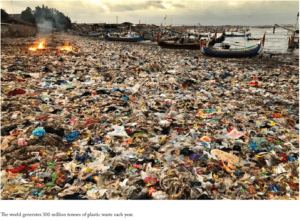One of the first conditions of happiness is that the link between man and nature shall not be broken-Leo Tolstoy, Renowned Author & Writer

While the climate crisis has many factors that play a role in the exacerbation of the environment, there are some that warrant more attention than others. Here are some of the biggest environmental problems of our lifetime:
- Global Warming from Fossil Fuels
In May 2023, CO2 part per million was at 420.00 and global temperature rise was at 1.15C compared to pre-industrial levels. The last time carbon-dioxide went that high was more than 4million years ago. Increased emissions of greenhouse gases have led to a rapid and steady increase in global temperatures, which in turn is causing catastrophic events all over the world from Australia and the US experiencing some of the most devastating bushfire seasons ever recorded, locusts swarming across parts of Africa, the Middle East and Asia, decimating crops, and a heatwave in Antarctica that saw temperatures rise above 20C for the first time. Scientists are constantly warning that the planet has crossed a series of tipping points that could have catastrophic consequences, such as advancing permafrost melt in Arctic regions, the Greenland ice sheet melting at an unprecedented rate, accelerating sixth mass extinction and increasing deforestation in the Amazon rainforest, just to name a few.
The climate crisis is causing tropical storms and other weather events such as hurricanes, heatwaves and flooding to be more intense and frequent than seen before. However, even if all greenhouse gas emissions were halted immediately, global temperatures would continue to rise in the coming years. That is why it is absolutely imperative that we start now to drastically reduce greenhouse gas emissions, invest in renewable energy sources, and phase our fossil fuels as fast as possible.
- Plastic Pollution
In 1950, the world produced more than 2 million tons of plastic per year. By 2015, this annual production swelled to 419 million tons and exacerbating plastic waste in the environment.
A report by science journal, Nature, determined that currently, roughly 14 million tons of plasticmake their way into the oceans every year, harming wildlife habitats and the animals that live in them. The research found that if no action is taken, the plastic crisis will grow to 29 million metric tons per year by 2040. If we include microplastics into this, the cumulative amount of plastic in the ocean could reach 600 million tons by 2040.
Shockingly, National Geographic found that 91% of all plastic that has ever been made is not recycled, representing not only one of the biggest environmental problems of our lifetime, but another massive market failure. Considering that plastic takes 400 years to decompose, it will be many generations until it ceases to exist. There’s no telling what the irreversible effects of plastic pollution will have on the environment in the long run.
- Biodiversity Loss
The past 50 years have seen a rapid growth of human consumption, population, global trade and urbanisation, resulting in humanity using more of the Earth’s resources than it can replenish naturally.
A recent WWF report found that the population sizes of mammals, fish, birds, reptiles and amphibians have experienced a decline of an average of 68% between 1970 and 2016. The report attributes this biodiversity loss to a variety of factors, but mainly land-use change, particularly the conversion of habitats, like forests, grasslands and mangroves, into agricultural systems. Animals such as pangolins, sharks and seahorses are significantly affected by the illegal wildlife trade, and pangolins are critically endangered because of it. More broadly, a recent analysis has found that the sixth mass extinction of wildlife on Earth is accelerating. More than 500 species of land animals are on the brink of extinction and are likely to be lost within 20 years; the same number were lost over the whole of the last century. The scientists say that without the human destruction of nature, this rate of loss would have taken thousands of years.
- Poor Governance
According to economists like Nicholas Stern, the climate crisis is a result of multiple market failures. Economists and environmentalists have urged policymakers for years to increase the price of activities that emit greenhouse gases (one of our biggest environmental problems), the lack of which constitutes the largest market failure, for example through carbon taxes, which will stimulate innovations in low-carbon technologies.
To cut emissions quickly and effectively enough, governments must not only massively increase funding for green innovation to bring down the costs of low-carbon energy sources, but they also need to adopt a range of other policies that address each of the other market failures. A national carbon tax is currently implemented in 27 countries around the world, including various countries in the EU, Canada, Singapore, Japan, Ukraine and Argentina. However, according to the 2019 OECD Tax energy use report, current tax structures are not adequately aligned with the pollution profile of energy sources. For example, the OECD suggests that carbon taxes are not harsh enough on coal production, although it has proven to be effective for the electricity industry. A carbon tax has been effectively implemented in Sweden; the carbon tax is U$127 per tonne and has reduced emissions by 25% since 1995, while its economy has expanded 75% in the same time period.
Further, organisations such as the United Nations are not fit to deal with the climate crisis: it was assembled to prevent another world war and is not fit for purpose. Anyway, members of the UN are not mandated to comply with any suggestions or recommendations made by the organisation. For example, the Paris Agreement, a historic deal within the United Nations Framework Convention on Climate Change, says that countries need to reduce greenhouse gas emissions significantly so that global temperature rise is below 2C by 2100, and ideally under 1.5C. But signing on to it is voluntary, and there are no real repercussions for non-compliance. Further, the issue of equity remains a contentious issue whereby developing countries are allowed to emit more in order to develop to the point where they can develop technologies to emit less, and it allows some countries, such as China, to exploit this.
- Food Waste
A third of the food intended for human consumption, around 1.3 billion tonnes is wasted or lost. This is enough to feed 3 billion people. Food waste and loss account for a third of greenhouse gas emissions annually; if it was a country, food waste would be the third highest emitter of greenhouse gases, behind China and the US.
Food waste and loss occurs at different stages in developing and developed countries; in developing countries, 40% of food waste occurs at the post-harvest and processing levels, while in developed countries, 40% of food waste occurs at the retail and consumer levels.
At the retail level, a shocking amount of food is wasted because of aesthetic reasons; in fact, in the US, more than 50% of all produce thrown away in the US is done so because it is deemed to be “too ugly” to be sold to consumers- this amounts to about 60 million tons of fruits and vegetables. This leads to food insecurity, another one of the biggest environmental problems on the list.
- Deforestation
Every hour, forests the size of 300 football fields are cut down. By the year 2030, the planet might have only 10% of its forests; if deforestation isn’t stopped, they could all be gone in less than 100 years. The three countries experiencing the highest levels of deforestation are Brazil, the Democratic Republic of Congo and Indonesia. The Amazon, the world’s largest rainforest, spanning 6.9 million square kilometres (2.72 million square miles) and covering around 40% of the South American continent is also one of the most biologically diverse ecosystems and is home to about three million species of plants and animals. Despite efforts to protect forest land, legal deforestation is still rampant, and about a third of global tropical deforestation occurs in Brazil’s Amazon forest, amounting to 1.5 million hectares each year.
Agriculture is the leading cause of deforestation, another one of the biggest environmental problems appearing on this list. Land is cleared to raise livestock or to plant other crops that are sold, such as sugar cane and palm oil. Besides for carbon sequestration, forests help to prevent soil erosion, because the tree roots bind the soil and prevent it from washing away, which also prevents landslides.
- Agriculture
Studies have shown that the global food system is responsible for up to one third of all human-caused greenhouse gas emissions, of which 30% comes from livestock and fisheries. Crop production releases greenhouse gases such as nitrous oxide through the use of fertilisers. 60% of the world’s agricultural area is dedicated to cattle ranching, although it only makes up 24% of global meat consumption.
Agriculture not only covers a vast amount of land, but it also consumes a vast amount of freshwater, another one of the biggest environmental problems on this list. While arable lands and grazing pastures cover one-third of Earth’s land surfaces, they consume three-quarters of the world’s limited freshwater resources.
Scientists and environmentalists have continuously warned that we need to rethink our current food system; switching to a more plant-based diet would dramatically reduce the carbon footprint of the conventional agriculture industry.
Credit
About the Writer
Ebenezer specializes in Development Communication, International Development, Innovative Finance for SMEs and Sustainability.
You can reach him via [email protected] & [email protected]










